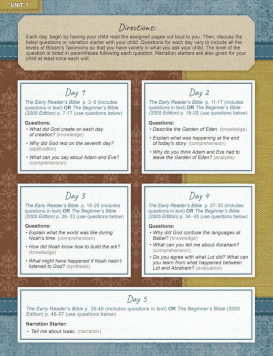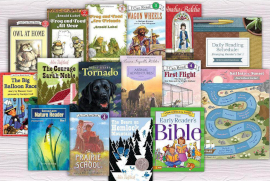Emerging Reader’s Set 1 and Set 2 were created by Heart of Dakota for use with their complete programs. But since children reach the emerging reader stage at different times--the stage where they have completed phonics instruction and can read beginning books, these two sets can be used whenever you wish alongside whatever program you are using. The sets provide children with reading practice using children’s books that gradually increase in difficulty. The reading is supported by “Guided Questions” that help children develop reading, critical thinking, and narration skills.
The two sets are sold by Heart of Dakota, complete with a parent guide and the required books, but you can purchase all items individually.
 The lovely, full-color, parent guide for each set is titled Daily Reading Schedule Set 1 (or 2) with Guided Questions. Along with each parent guide, you get a colorful progress chart and stickers for children to affix as they complete each book. The spiral-bound guides schedule reading and discussion for five days per week for 34 weeks, so you will spend a school year working through each guide if you stay on schedule. One page per day lays out each day’s reading assignment and questions in individual boxes. For four of the days, the reading assignment is followed by three questions that are identified as focusing on knowledge, comprehension, application, analysis, synthesis, or evaluation (based on Benjamin Bloom’s Taxonomy of Educational Objectives). The fifth day lists the reading assignment followed by a “Narration Starter,” such as, “What did Aunt Dora tell Noah about the stars and about reading?” (from the Set 1 guide, Unit 16), which gives children the opportunity to provide lengthier explanations or summaries.
The lovely, full-color, parent guide for each set is titled Daily Reading Schedule Set 1 (or 2) with Guided Questions. Along with each parent guide, you get a colorful progress chart and stickers for children to affix as they complete each book. The spiral-bound guides schedule reading and discussion for five days per week for 34 weeks, so you will spend a school year working through each guide if you stay on schedule. One page per day lays out each day’s reading assignment and questions in individual boxes. For four of the days, the reading assignment is followed by three questions that are identified as focusing on knowledge, comprehension, application, analysis, synthesis, or evaluation (based on Benjamin Bloom’s Taxonomy of Educational Objectives). The fifth day lists the reading assignment followed by a “Narration Starter,” such as, “What did Aunt Dora tell Noah about the stars and about reading?” (from the Set 1 guide, Unit 16), which gives children the opportunity to provide lengthier explanations or summaries.
Set 1
The guide for Set 1 requires 13 children’s picture books and either The Early Reader’s Bible or The Beginner’s Bible. The Bible will be used for the first nine weeks, so you will almost certainly want to purchase it, even if you want to access the other books through your library.
Both Bibles have over 500 pages with plentiful, full-color illustrations. The Early Reader’s Bible is a little easier to read since it relies primarily on a list of 250 words commonly used in beginning readers. It introduces another 200 words, including biblical vocabulary but no more than five such words in each of its 64 stories. It adds discussion questions and simple activities. (The parent guide lets you know when questions in The Early Reader’s Bible can be used in place of those in the guide.) The Beginner’s Bible retells more than 90 Bible stories using more advanced vocabulary than The Early Reader’s Bible. For instance, on page five of The Early Reader’s Bible, it says, “So God made the moon and the stars.” On page 11 of The Beginner’s Bible, both the sentences and the vocabulary are more complex: “He put a glowing moon and twinkling stars in the sky for nighttime.”
The other 13 books begin with easy readers, such as Owl at Home and Frog and Toad All Year, advancing in difficulty, with the last book being The Courage of Sarah Noble. Most of the books are children’s favorite fiction books, but the Christian Liberty Nature Reader Book 1 adds non-fiction content as children read about insects and animals.
The Set 1 parent guide includes a two-page list of “Supplemental Book Titles: Emerging Reader’s Set 1.” One additional book is recommended per week for those who want to add another book on a reading level comparable to the assigned book. There are no discussion questions for the supplemental books.
Set 2
Set 2 uses 20 children’s chapter books that gradually become more difficult. The first few books are Buddy: The First Seeing Eye Dog, Helen Keller: Courage in the Dark, and A Long Road on a Short Day. Children conclude the course with Sarah, Plain and Tall and Saving Sammy. The books are about adventures, animals, mysteries, biographies, historical fiction, and fantasy. One book, Pulling Together by Dawn L. Watkins, is about reliance on God. but the rest are not overtly religious. Each book is used for two to four weeks, so you might be able to borrow them from the library.
When children complete Set 2, they should be ready to move on to the first level of Heart of Dakota’s Drawn into the Heart of Reading.
Summary
The two Emerging Reader’s sets are great for helping shift children into independent reading with carefully selected books, and the discussion questions extend the use of each set of real books so they can serve as your entire reading program.








